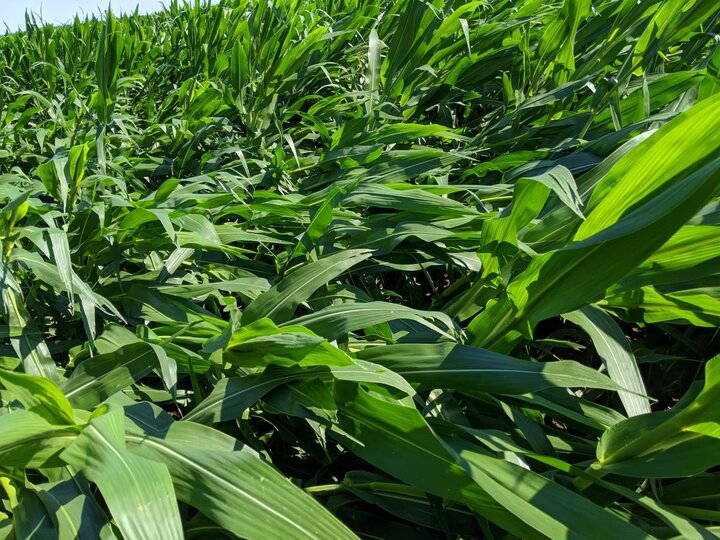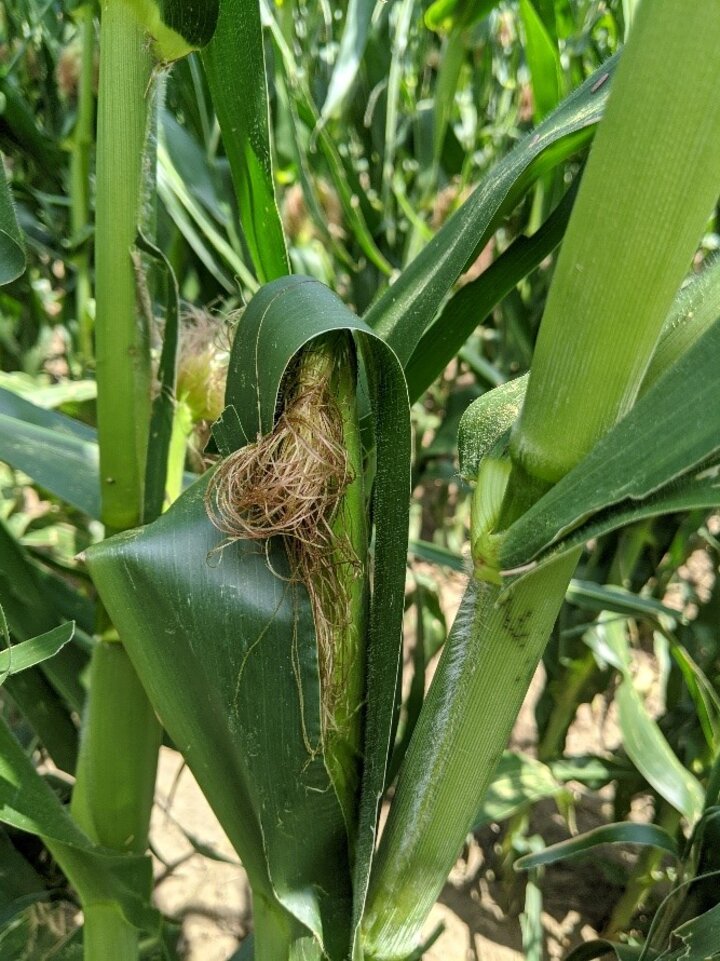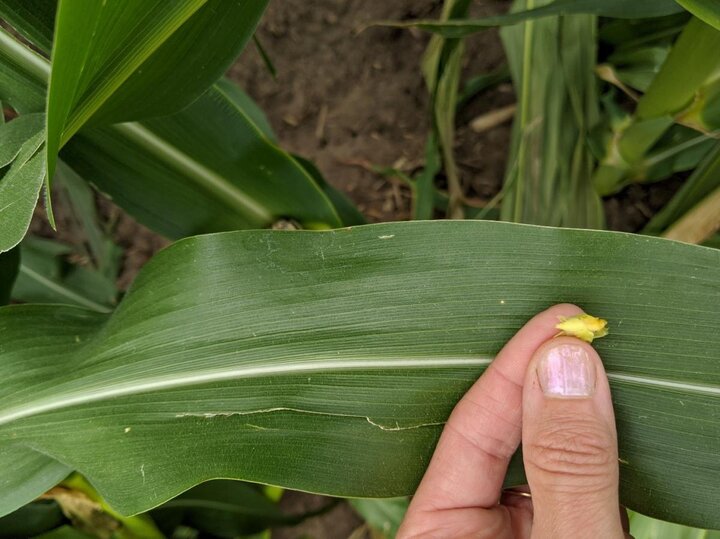Key Points:
- High winds caused lodging, pinching, snapping of plants prior to pollination in July 2020.
- Research found lodged plants had yield reductions of 2-6% (V10-12 stage), 5-15% (V13-15 stage), and 12-31% (V17 and after stages).
- In the worst case situation, yield reduction from greensnap (below ear) may range up to a 1:1 percent broken:yield loss. It is possible that these losses will be as low as 1:0.73 or even 1:0.50 losses.
- Wait and observe any additional issues including with pollination, ear formation, and ear loss.
Weather Data
July has resulted in numerous storm events. According to the Storm Prediction Center preliminary storm reports, so far there have been 16 tornado reports issued, 68 hail reports, and 197 wind reports this month. June severe weather reports included 6 tornadoes, 138 hail reports, and 169 wind reports. These reports are preliminary and will be finalized within six months by the National Center for Environmental Information.
During the last week the convective systems have produced impressive peak wind gusts. A peak gust of 94 mph was reported at the Sidney Airport on the 8th, 91 mph at McCook on the 10th, 100 mph estimate near Broken Bow on the 12th, and 87 mph at North Platte on the 13th. There were at least 15 reports over 70 mph on the 8th.
In addition to the 94 mph Sidney report, Malcom reported a 75 mph gust, while Carleton and Long Pine reported 75 mph gusts. Figures 1 and 2 show preliminary damage reports for July 8 and July 10, 2020.


Data from July 2-13 are summarized in Table 1. Prior to storms July 8-9, plants were nearing tassel, a critical time for photosynthesis and pollination. These storms resulted in “flattened” corn from lodging/leaning in addition to bent and snapped plants. ‘Recovery’ would be defined as the plants righting themselves, re-establishing roots, and re-orienting leaves. The severity and amount of recovery for every field situation will vary depending on the soil moisture at time of the wind, root mass structure, hybrid planted, severity of leaning/bent/snapped plants, and growth stage of the plants. It will also depend on where the bending, pinching, and snapping of those plants occurred. This article will share research that is known in addition to observations of what can be anticipated in the recovery process.
| Date | Tornado | Hail | Wind |
|---|---|---|---|
| 7/2 | 3 | 14 | 8 |
| 7/3 | 0 | 2 | 0 |
| 7/6 | 0 | 2 | 7 |
| 7/7 | 0 | 0 | 2 |
| 7/8 | 13 | 11 | 93 |
| 7/9 | 0 | 8 | 15 |
| 7/10 | 0 | 17 | 38 |
| 7/12 | 0 | 14 | 12 |
| 7/13 | 0 | 1 | 22 |
Lodged Plants
Lodging, ‘flattening’, or ‘steamrolling’ of plants occurs when plants essentially lie down without breaking (Figure 3 with recovery example in Figure 4). Plants may be anywhere from one to several feet off the ground and fields can look devastating. Lodging can occur from any or a combination of these factors: the hybrid and plant development stage (as hybrids are increasingly bred to withstand greensnap), soil moisture (higher soil moisture content at the time of high winds can result in greater lodging), root development, and corn rootworm larvae damage to roots.


Lodging creates some uncertainty regarding how the plant will respond. If the plant can’t reorient stalks and leaves, there’s a reduction of photosynthesis as some leaves are shaded. There can also be reduced and/or poor pollination with leaves covering silks (Figure 5). Roots without soil contact reduce the plant’s ability to uptake water and nutrients.



It is more difficult to know how lodged and bent plants will recover and the impact on developing ears than cases where plants break completely. This is because it’s unknown how pollination will occur due to silks being covered, how plants will re-orient themselves, impacts of the bending on movement of water and nutrients throughout the plant, and ability of roots to re-establish themselves to transport water and nutrients. Since July 8th, plants in fields in the York, Seward, Clay, Fillmore, Thayer, and Nuckolls county areas have worked hard to upright themselves. West winds had lodged plants to the east.
As plants approach tasseling and beyond, stalks are less flexible and able to reorient themselves. Bending often occurs more in the top portions of the plant as they are more flexible than lower portions. Since the storm, observations of recovery include plants bending at several nodes to upright themselves (Figure 6a and b) and root development on both the leeward side to help ‘push’ plants up and roots and on the windward side possibly to stabilize the plant (Figure 7).



Carter and Hudelson (1988) from the University of Wisconsin conducted a study where they manually pushed the base of corn plants perpendicular to row direction after irrigating to saturate the soil. The study was conducted for two years. They noted that within two days after lodging, the upper portion of plants became upright and subsequent timing of plant development was not impacted. However, more barren plants were observed when lodging occurred at later development stages, impacting yield. Corn lodged at V10-12 stages resulted in a 2-6% yield reduction. Corn lodged at V13-15 resulted in a yield reduction of 5-15%. Corn lodged after V17 resulted in a 12-31% yield reduction.
Snapped Plants
Plants snapped below the ear are obviously a complete loss while plants snapped above the ear have loss of yield potential. In fields with greater incidence of lodged and bent plants from recent storms, we are only seeing/hearing reports of 1-15% greensnap. Reports of greensnap have occurred at higher levels in seed corn, popcorn, and late-planted corn fields that were in the V8-V12 development stages (rapid growth). We’re unfortunately hearing reports and seeing incidence of 25-85% greensnap in those situations. (Figure 8).
An interesting observation is growth of ‘baby ears’ on some plants snapped below ears. These won’t amount to anything, but it points to the resiliency of plants in trying to survive and reproduce (Figure 9).



Elmore and Ferguson (1999) measured mid-season corn stalk breakage on over 100 hybrids in south central Nebraska resulted from 100 mph winds on July 8, 1993 and 80 mph winds on July 1, 1994. Corn development stages at the time of damage ranged from V10 to V14. In 1993 stalk breakage ranged from 7 to 88%, and grain yield was reduced 1.5 bu/acre for every 1% increase in stalk breakage. Breakage in 1994 ranged from 1 to 37% at one site and from 5 to 51% at the other site. Grain yield was reduced by 1.5 and 1.8 bu/acre for every 1% increase in stalk breakage. Remaining plants did not compensate for grain loss from broken plants at any site. Percentage yield loss is directly related to percentage stalk breakage. That is a 1:1 loss.
However, newer data indicate that the impact may not be as severe as a 1:1 loss. Iowa State University work found that yields resulting from breakage below the ear were not as severe as we previously thought. In the two years of work, the percent broken:percent yield reduction ranged from about 1:0.50 to 1:0.73, considerably better than the older reports of a 1:1 loss. Breakage above the ear had even less negative yield consequences. This information suggests that standing plants compensate to some degree for the loss of their neighboring broken plants.
In the worst case situation, yield reduction from greensnap may range up to a 1:1 percent broken:yield loss. It is possible that these losses will be as low as 1:0.73 or even 1:0.50 losses.
What to Expect?
It really depends how plants are able to recover. For fields very close to tassel with severe bending near ears, we may see pollination, possibly even ear formation issues. Watch pollination impacts with leaves covering silks. Some leaning plants may be minimally impacted after uprighting themselves. The weight on these bent stalks may be too great as the ears develop resulting in stalk breakage. We’re also anticipating a challenging harvest.
We all will learn a lot and we encourage everyone to share observations! Jenny flagged plants in a number of fields to watch recovery and pollination/ear development. It would be great if many farmers and agronomists did the same and shared results so we can all learn together!
Next Steps:
- Be patient and wait, observe, call crop insurance.
- Avoid applying heavy amounts of water to allow plants to continue to right themselves and separate without the extra water weight.
- Don’t apply fertilizer. Consider taking tissue and/or soil samples if you had a fertigation scheduled. We’ve seen increased mineralization this year due to the heat, so additional nitrogen may not be necessary.
- Wait to apply insecticides and/or fungicides. Watch insect pressure, particularly rootworm and Japanese beetles, for silk clipping. Disease pressure is very low this year. Economically, we need to see how each field recovers before putting more into the crop. Plants are already stressed so give them time to try to recover; a fungicide can’t help with this amount of plant stress. Every field looked at thus far contains a range of growth stages (several leaves prior to tassel through tasseling) at time of writing this. Be very careful with any pesticide applications (regarding adjuvants added or in product formations) made to plants pre-tassel to reduce additional ear formation issues.
Resources:
Elmore, Roger. July 12, 2011. Wind and Corn. ICM News. Iowa State University.
Lauer, Joe. July 11, 2011. Yield Response to Flattened (Lodged) Corn. University of Wisconsin Agronomy Department.
Nafziger, Emerson. June 23, 2016. Storm Damage in Corn. University of Illinois Extension.
Nielsen, R.L. (Bob). July 12, 2013. Damage to Corn Plants by Strong Winds. Purdue University.
